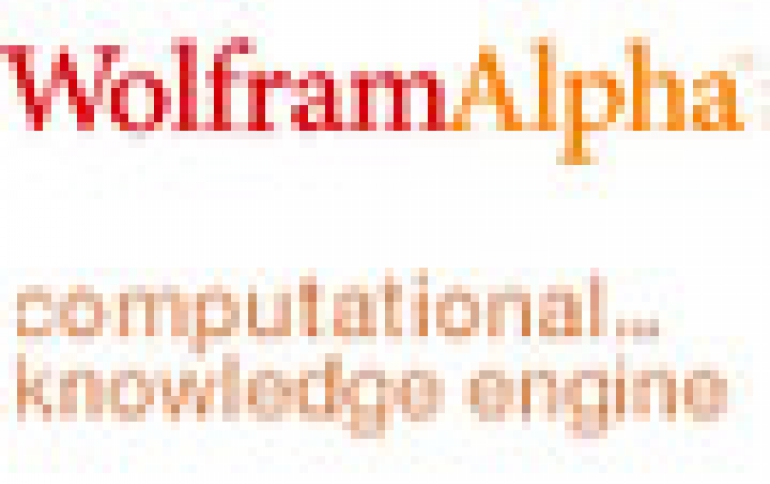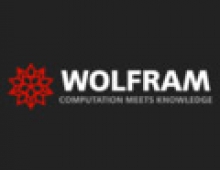
Wolfram Alpha Officially Launched
Wolfram Alpha LLC announced the general availability of Wolfram Alpha, the world's first computational knowledge engine, offered for free on the web.
Wolfram Alpha draws on scientist Stephen Wolfram's work on Mathematica, the world's leading technical computing software platform, and on the discoveries he published in his paradigm-shifting book, A New Kind of Science.
The long-term goal of Wolfram Alpha is to make all systematic knowledge immediately computable and accessible to everyone. Wolfram Alpha draws on multiple terabytes of curated data and synthesizes it into entirely new combinations and presentations. The service answers questions, solves equations, cross-references data types, projects future behaviors, and more. Wolfram Alpha's examples pages and gallery show a few of the many uses of this new technology.
"Fifty years ago," said Stephen Wolfram, the founder and CEO of Wolfram Research, "when computers were young, people assumed that they'd be able to ask a computer any factual question, and have it compute the answer. I'm happy to say that we've successfully built a system that delivers knowledge from a simple input field, giving access to a huge system, with trillions of pieces of curated data and millions of lines of algorithms. Wolfram Alpha signals a new paradigm for using computers and the web."
Wolfram Alpha is made up of four main "pillars" or components:
- Curated Data. Wolfram Alpha contains terabytes of factual data covering a wide range of fields. Teams of subject-matter experts and researchers collect and curate data, transforming it into computable forms that can be understood and operated on by computer algorithms.
- Dynamic Computation. When Wolfram Alpha receives a user query, it extracts the relevant facts from its stored computable data and then applies a collection of tens of thousands of algorithms, creating and synthesizing new relevant knowledge.
- Intuitive Language Understanding. To allow Wolfram Alpha to understand inputs entered in everyday language, its developers examine the ways people express ideas within fields and subject matters and continually refine algorithms that automatically recognize these patterns.
- Computational Aesthetics. Wolfram Alpha also represents a new approach to user-interface design. The service takes user inputs and builds a customized page of clearly and usefully presented computed knowledge.
Wolfram Alpha has been entirely developed and deployed using Wolfram Research, Inc.'s Mathematica technology. Wolfram Alpha contains nearly six million lines of Mathematica code, authored and maintained in Wolfram Workbench. In its launch configuration, Wolfram Alpha is running Mathematica on about 10,000 processor cores distributed among five colocation facilities, using gridMathematica-based parallelism. And every query that comes into the system is served with webMathematica.
Powering Wolfram Alpha's computational knowledge engine required highly specialized servers and compute clusters.
Dell's Data Center Solutions (DCS) Division worked with R Systems NA, Inc., Wolfram Alpha's data-center hosting partner, to identify the right customized cloud computing solution and tune it to R Systems' facility, operating processes, and application workload.
The long-term goal of Wolfram Alpha is to make all systematic knowledge immediately computable and accessible to everyone. Wolfram Alpha draws on multiple terabytes of curated data and synthesizes it into entirely new combinations and presentations. The service answers questions, solves equations, cross-references data types, projects future behaviors, and more. Wolfram Alpha's examples pages and gallery show a few of the many uses of this new technology.
"Fifty years ago," said Stephen Wolfram, the founder and CEO of Wolfram Research, "when computers were young, people assumed that they'd be able to ask a computer any factual question, and have it compute the answer. I'm happy to say that we've successfully built a system that delivers knowledge from a simple input field, giving access to a huge system, with trillions of pieces of curated data and millions of lines of algorithms. Wolfram Alpha signals a new paradigm for using computers and the web."
Wolfram Alpha is made up of four main "pillars" or components:
- Curated Data. Wolfram Alpha contains terabytes of factual data covering a wide range of fields. Teams of subject-matter experts and researchers collect and curate data, transforming it into computable forms that can be understood and operated on by computer algorithms.
- Dynamic Computation. When Wolfram Alpha receives a user query, it extracts the relevant facts from its stored computable data and then applies a collection of tens of thousands of algorithms, creating and synthesizing new relevant knowledge.
- Intuitive Language Understanding. To allow Wolfram Alpha to understand inputs entered in everyday language, its developers examine the ways people express ideas within fields and subject matters and continually refine algorithms that automatically recognize these patterns.
- Computational Aesthetics. Wolfram Alpha also represents a new approach to user-interface design. The service takes user inputs and builds a customized page of clearly and usefully presented computed knowledge.
Wolfram Alpha has been entirely developed and deployed using Wolfram Research, Inc.'s Mathematica technology. Wolfram Alpha contains nearly six million lines of Mathematica code, authored and maintained in Wolfram Workbench. In its launch configuration, Wolfram Alpha is running Mathematica on about 10,000 processor cores distributed among five colocation facilities, using gridMathematica-based parallelism. And every query that comes into the system is served with webMathematica.
Powering Wolfram Alpha's computational knowledge engine required highly specialized servers and compute clusters.
Dell's Data Center Solutions (DCS) Division worked with R Systems NA, Inc., Wolfram Alpha's data-center hosting partner, to identify the right customized cloud computing solution and tune it to R Systems' facility, operating processes, and application workload.





















